My 928 Projects Master Thread
#1
Addict
Rennlist Member
Rennlist Member
Thread Starter
I have some interesting projects on the go, some of you may be interested in seeing what they are and others may be interested in joining in parts of the various projects.
Starting with the transmission and driveline. The standard Porsche driveline is inadequate for the rpms and power levels that the planned engine will produce. So without going to the sequential trannys that are around as I don't want to drive one of those on the street the best alternative is the Corvette box.
I have made some enquires regarding the strength and and I have the basic dimensions of the TR6070 and this box comes with an integrated oil pump. The transmission place upgrades these boxes with carbon synchros and the gears are superfinished and whole transmission is cryogenically treated.
The only issue the trans place raised was the shifting at high RPMs, this is where there is some risk to the project, they say with a standard driveline there is a marked drop of in shift quality at 7,500 rpm. So if you are going higher than this I would suggest the rest on the changes made to the torque tube will be relevant. I have a Tilton triple plate 7.25" clutch and there will be a custom carbon driveshaft. This will drop the mass forces and this the trans place believes will help in high rpm shifting. Remember you fight mass forces when changing in a trans with syncros.
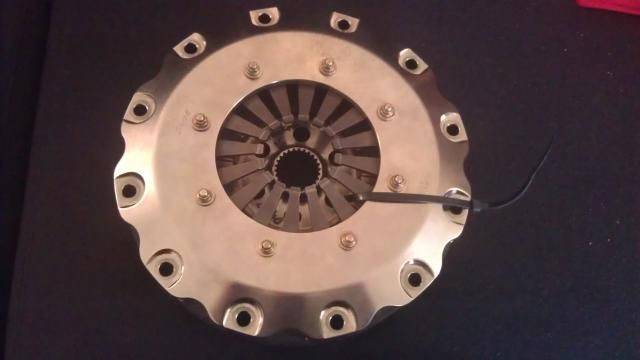


Here's an example;
http://www.maperformance.com/pfadt-r...5-1121020.html
A 52% reduction in mass and you can see just how strong these shafts are.
The carbon clutch although we shouldn't count all of the weight of the clutch only weighs 3.2 kgs (these clutches are often used in Corvettes) and the flywheel and crankshaft will lose a lot of weight over factory items. We will also do away with the little shaft and coupling. The coupling is a weak point and I am glad to get rid of it although the convenience factor of the 928 clutch servicing is reduced.
Personally we are using an advanced ECU that can run a sequential shift box and it of course has other strategies that can rev match and again this may be called on to assist with fast changes. The TR6070 from GM has the factory rev match system fitted and I think we will be able to implement this also but I will reserve judgement on that at this point. However I am hopeful that we can get this to work, there is several engineers helping on the project so that will give the best chance for success. I incidentally had the wiring fellow staying with me while he did his work on one of the looms being made. He said that the support for the ECU was good from the company and that when put into communication mode, changes can be made live from the UK. Pretty amazing to be able to make changes to a running engine from 12,000 miles away. The ECU has 6 switchable engine maps that are very easy to copy and paste and can very useful in running a street and then a race mode with different variations.
With regard to the differential, it will not be a corvette differential, I have had discussions with a gear maker and we intend to use the Porsche 928 style crown wheel and pinion, the ratio I think that is best is 4:11. This will be made in style that would fit the 928 auto. This is where partners in this project would be helpful as the cost of the first crown wheel and pinion is expensive at around $9,000 USD. The tranny will also get a custom mainshaft which is also the output shaft in the TR6070. This custom part hasn't been quoted but again the first one will be at least $3000 USD I would think. Price drop dramatically when 5 sets are made.
The mainshaft will be made so that when an adaptor/sandwich plate is custom made the rear of the 928 auto style differential housing can be bolted directly to it. So this will become like a factory fit. The 928 differential will be set up as per factory spec. The crown wheel and pinion btw are far and away upgraded over what is really excellent factory spec when we are talking strength. Also this company will supply unequal diameter driveshafts and billet housing for the CV joints, these parts are not overly expensive and will make the driveline bloody strong. The unequal diameter shafts are used to reduce resonance and resultant wheel hop.
The Corvette transmissions supplier asked why not use the corvette differential, it may be simpler, I said that has actually been done and I acknowledge the hard work and various different means of achieving this swap. For myself I would rather just change the transmission and torque tube/driveshaft/clutch assembly as this will fit the best. The standard factory mounting points can be used and the packaging is neater. Also and this is a big one, the PSD system for racing/track work can be utilised.
One of the consulting engineers I have engaged has extensive experience in this field, he used to write these algorithms at the very top levels of motorsport. He has a number of options regarding the algorithms and he was amazed that the 928 came with such a system. When I showed him the diff centre he said "where did you get that!" he was excited to be involved in this project and we have contacted the ECU manufacturer to get the firmware written to run the algorithm. This is in progress but I suspect it will be slow to happen but be done by the time we go to fire up the car.
His programs allow a lot of flexibility and 3 to 4 cabin adjustable dials are foreseen. A entry, mid and exit and perhaps a gain switch also. There is also the locking of the differential under braking for stability. This will create the ultimate in 928 differentials with resultant excellent stability and traction out of corners. This engineers other speciality is vehicle dynamics. So what is learned from the suspension I can also pass on. It was interesting that the current aftermarket spring rates that are being generally used in 928s i.e front to rear spring rate relationships, he believes is are most likely wrong.
The other project regarding the vehicle dynamics is the brakes. As some would know my car has the F50 front brakes and 993 Turbo rears. I will keep this setup for the wife's car and we are fitting 997 Turbo front and rear brakes. Therefor front brakes are 6 piston but more importantly greater pad area. The other very important upgrade will the brake rotors. These are made by the best in the business PFC. The rotor being used be the 350 mm rotor with 60 mm annulus. This will be used with their latest and unmatched bobbin system.
You can read about it here along with their other technology regarding their rotors;
http://www.pfcbrakes.com.au/technology.php?pageId=15
The rears use the advanced 4 piston calliper from the 997 Turbo it is a calliper that has a bridge over the pads and has a wide pad selection because it comes from the Turbo and GT3. These will be very lightweight but super efficient brakes that require 18" wheels.
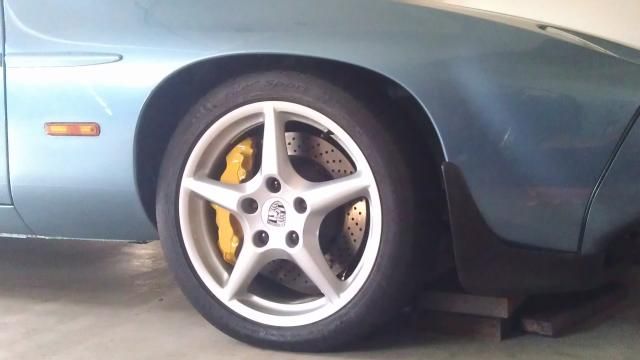
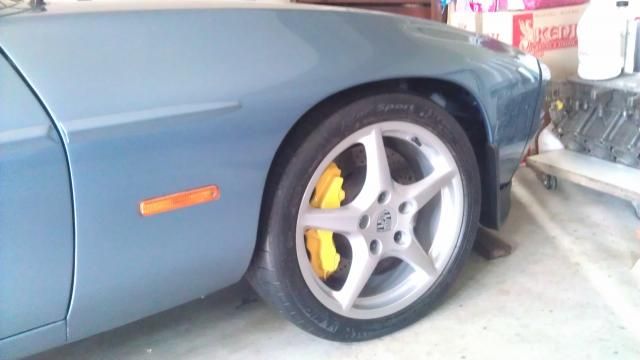
So the custom pieces are an adaptor for the front calliper and hat, for the rear an adaptor and again a adaptor which changes the mount from radial to side or lateral mounting. The disc is around 348 mm in diameter and 28 mm thick.
So again you will have the opportunity to join in this project. You can see a mock up of the front brakes here. I am also using the Bosch Motorsport ABS adjustable system. It has 9 presets for various levels of aggressiveness, in fact the sensors used on this system are very useful and we are using these sensors to help with the active differential. It sends its signals to the can bus we are installing.
We will also look at a very advanced feature that can be tied in which is "yaw control" this wont be tackled straight away as we sort the car (there will be plenty to sort!) with what we have first but yaw control is tied into the active diff. The engineer says this will be quite a lot of work so it may not happen. If you are not sure what yaw control is you can view this clip. They call it SSC or side slip angle control.
Just for the sake of an interesting option and tidbit of info (that I wont be employing) It is possible as it is only a software upgrade to the Bosch system but EBD is available. It is effectively a pre ABS. When they banned ABS in F1 they found an interesting way to help get some way back to the maximum effective braking force. They have a clock type spring in the front of the car to change brake pressures from left to right. So as you went into a hard left hander the pressure would reduce on the left hand side and increase on the right hand side to assist in maximum braking. This is basically what EBD does. I am not sure if that feature is still allowed in F1, they ban so many things.
Other projects that will be under way are the engine, not all parts of that project are share-able as they are just to hard and finnicky to achieve. I do however want to have some custom cranks made. This is my preference, to have a top manufacturer of crankshafts make the crank for the high rpm engine. So the min order is 3 cranks. They will be around 90 mm in stroke and use the IRL rod journal which is 47 mm. For the width I think I would spec the big block chevy width which is 2" and this will allow others who may not want to run piston guided rods (like mine pictured) to use crank guided rods with the right offsets. The smaller journals have good bearing selection and advantages like which I have extolled for many years. From conversations with the crank maker a guide weight of 22 kgs is where it should come out. This is with the 8cwt design. Personally I will be running tight clearances with a lower vis oil to lower the friction.
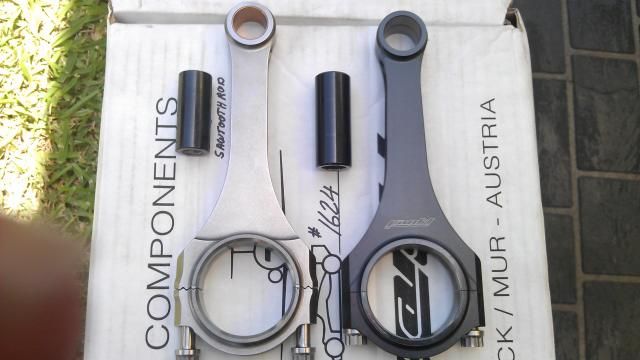
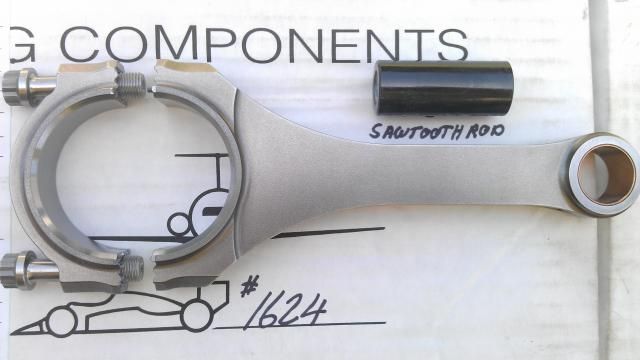
If we can't get three cranks together for order I will go the Moldex route and I then will investigate the cost of changing to a modern set of smaller main bearings. Our bearing are outdated technology wise and can't be fixed. We may be able to retain the thrust bearing and have the others smaller but using far less grooving. The current grooving is greatly adding to friction. You only need to look at the main bearing wear to see what the extra grooving is doing to wear and friction. However I know not everybody want to go to this trouble and even I have to look carefully at what costs might be incurred by these changes but I think it will be really worth it. Superfinishing the crank is not however a big cost, around $500 and is worth it especially with tight clearances.
I have previously been asked to condense what is happening as having too many threads is a bit all over the place so I will try to link topics or most topics into this thread.
I may not have a lot of time to answer PMs but we can kick it around on the board to get a better understanding of what is being done and how.
Starting with the transmission and driveline. The standard Porsche driveline is inadequate for the rpms and power levels that the planned engine will produce. So without going to the sequential trannys that are around as I don't want to drive one of those on the street the best alternative is the Corvette box.
I have made some enquires regarding the strength and and I have the basic dimensions of the TR6070 and this box comes with an integrated oil pump. The transmission place upgrades these boxes with carbon synchros and the gears are superfinished and whole transmission is cryogenically treated.
The only issue the trans place raised was the shifting at high RPMs, this is where there is some risk to the project, they say with a standard driveline there is a marked drop of in shift quality at 7,500 rpm. So if you are going higher than this I would suggest the rest on the changes made to the torque tube will be relevant. I have a Tilton triple plate 7.25" clutch and there will be a custom carbon driveshaft. This will drop the mass forces and this the trans place believes will help in high rpm shifting. Remember you fight mass forces when changing in a trans with syncros.



Here's an example;
http://www.maperformance.com/pfadt-r...5-1121020.html
A 52% reduction in mass and you can see just how strong these shafts are.
The carbon clutch although we shouldn't count all of the weight of the clutch only weighs 3.2 kgs (these clutches are often used in Corvettes) and the flywheel and crankshaft will lose a lot of weight over factory items. We will also do away with the little shaft and coupling. The coupling is a weak point and I am glad to get rid of it although the convenience factor of the 928 clutch servicing is reduced.
Personally we are using an advanced ECU that can run a sequential shift box and it of course has other strategies that can rev match and again this may be called on to assist with fast changes. The TR6070 from GM has the factory rev match system fitted and I think we will be able to implement this also but I will reserve judgement on that at this point. However I am hopeful that we can get this to work, there is several engineers helping on the project so that will give the best chance for success. I incidentally had the wiring fellow staying with me while he did his work on one of the looms being made. He said that the support for the ECU was good from the company and that when put into communication mode, changes can be made live from the UK. Pretty amazing to be able to make changes to a running engine from 12,000 miles away. The ECU has 6 switchable engine maps that are very easy to copy and paste and can very useful in running a street and then a race mode with different variations.
With regard to the differential, it will not be a corvette differential, I have had discussions with a gear maker and we intend to use the Porsche 928 style crown wheel and pinion, the ratio I think that is best is 4:11. This will be made in style that would fit the 928 auto. This is where partners in this project would be helpful as the cost of the first crown wheel and pinion is expensive at around $9,000 USD. The tranny will also get a custom mainshaft which is also the output shaft in the TR6070. This custom part hasn't been quoted but again the first one will be at least $3000 USD I would think. Price drop dramatically when 5 sets are made.
The mainshaft will be made so that when an adaptor/sandwich plate is custom made the rear of the 928 auto style differential housing can be bolted directly to it. So this will become like a factory fit. The 928 differential will be set up as per factory spec. The crown wheel and pinion btw are far and away upgraded over what is really excellent factory spec when we are talking strength. Also this company will supply unequal diameter driveshafts and billet housing for the CV joints, these parts are not overly expensive and will make the driveline bloody strong. The unequal diameter shafts are used to reduce resonance and resultant wheel hop.
The Corvette transmissions supplier asked why not use the corvette differential, it may be simpler, I said that has actually been done and I acknowledge the hard work and various different means of achieving this swap. For myself I would rather just change the transmission and torque tube/driveshaft/clutch assembly as this will fit the best. The standard factory mounting points can be used and the packaging is neater. Also and this is a big one, the PSD system for racing/track work can be utilised.
One of the consulting engineers I have engaged has extensive experience in this field, he used to write these algorithms at the very top levels of motorsport. He has a number of options regarding the algorithms and he was amazed that the 928 came with such a system. When I showed him the diff centre he said "where did you get that!" he was excited to be involved in this project and we have contacted the ECU manufacturer to get the firmware written to run the algorithm. This is in progress but I suspect it will be slow to happen but be done by the time we go to fire up the car.
His programs allow a lot of flexibility and 3 to 4 cabin adjustable dials are foreseen. A entry, mid and exit and perhaps a gain switch also. There is also the locking of the differential under braking for stability. This will create the ultimate in 928 differentials with resultant excellent stability and traction out of corners. This engineers other speciality is vehicle dynamics. So what is learned from the suspension I can also pass on. It was interesting that the current aftermarket spring rates that are being generally used in 928s i.e front to rear spring rate relationships, he believes is are most likely wrong.
The other project regarding the vehicle dynamics is the brakes. As some would know my car has the F50 front brakes and 993 Turbo rears. I will keep this setup for the wife's car and we are fitting 997 Turbo front and rear brakes. Therefor front brakes are 6 piston but more importantly greater pad area. The other very important upgrade will the brake rotors. These are made by the best in the business PFC. The rotor being used be the 350 mm rotor with 60 mm annulus. This will be used with their latest and unmatched bobbin system.
You can read about it here along with their other technology regarding their rotors;
http://www.pfcbrakes.com.au/technology.php?pageId=15
The rears use the advanced 4 piston calliper from the 997 Turbo it is a calliper that has a bridge over the pads and has a wide pad selection because it comes from the Turbo and GT3. These will be very lightweight but super efficient brakes that require 18" wheels.


So the custom pieces are an adaptor for the front calliper and hat, for the rear an adaptor and again a adaptor which changes the mount from radial to side or lateral mounting. The disc is around 348 mm in diameter and 28 mm thick.
So again you will have the opportunity to join in this project. You can see a mock up of the front brakes here. I am also using the Bosch Motorsport ABS adjustable system. It has 9 presets for various levels of aggressiveness, in fact the sensors used on this system are very useful and we are using these sensors to help with the active differential. It sends its signals to the can bus we are installing.
We will also look at a very advanced feature that can be tied in which is "yaw control" this wont be tackled straight away as we sort the car (there will be plenty to sort!) with what we have first but yaw control is tied into the active diff. The engineer says this will be quite a lot of work so it may not happen. If you are not sure what yaw control is you can view this clip. They call it SSC or side slip angle control.
Just for the sake of an interesting option and tidbit of info (that I wont be employing) It is possible as it is only a software upgrade to the Bosch system but EBD is available. It is effectively a pre ABS. When they banned ABS in F1 they found an interesting way to help get some way back to the maximum effective braking force. They have a clock type spring in the front of the car to change brake pressures from left to right. So as you went into a hard left hander the pressure would reduce on the left hand side and increase on the right hand side to assist in maximum braking. This is basically what EBD does. I am not sure if that feature is still allowed in F1, they ban so many things.
Other projects that will be under way are the engine, not all parts of that project are share-able as they are just to hard and finnicky to achieve. I do however want to have some custom cranks made. This is my preference, to have a top manufacturer of crankshafts make the crank for the high rpm engine. So the min order is 3 cranks. They will be around 90 mm in stroke and use the IRL rod journal which is 47 mm. For the width I think I would spec the big block chevy width which is 2" and this will allow others who may not want to run piston guided rods (like mine pictured) to use crank guided rods with the right offsets. The smaller journals have good bearing selection and advantages like which I have extolled for many years. From conversations with the crank maker a guide weight of 22 kgs is where it should come out. This is with the 8cwt design. Personally I will be running tight clearances with a lower vis oil to lower the friction.


If we can't get three cranks together for order I will go the Moldex route and I then will investigate the cost of changing to a modern set of smaller main bearings. Our bearing are outdated technology wise and can't be fixed. We may be able to retain the thrust bearing and have the others smaller but using far less grooving. The current grooving is greatly adding to friction. You only need to look at the main bearing wear to see what the extra grooving is doing to wear and friction. However I know not everybody want to go to this trouble and even I have to look carefully at what costs might be incurred by these changes but I think it will be really worth it. Superfinishing the crank is not however a big cost, around $500 and is worth it especially with tight clearances.
I have previously been asked to condense what is happening as having too many threads is a bit all over the place so I will try to link topics or most topics into this thread.
I may not have a lot of time to answer PMs but we can kick it around on the board to get a better understanding of what is being done and how.
#4
Archive Gatekeeper
Rennlist Member
Rennlist Member
22 kg (48.5 lb) 8 cwt crankshaft? A stock GTS crank is 28.5 kg, or 62.7 pounds. I'll be very interested to see 14 pounds removed.
As they say, subscribed.
As they say, subscribed.

#5
Addict
Rennlist Member
Rennlist Member
Thread Starter
Hi Rob,
That sneeky weight is hiding everywhere! Fortunately if I have to design the crank myself I have a pretty good idea of what to do. My last stroker crank which was the first 928 crank I believe that tried to save weight and reduce friction by way of smaller rod journals, it weighed 26.7 kgs. Now that crank wasn't balanced, so more weight was to be removed and that would have bought it to around 26.5 kgs. That crank was also 90 mm stroke, so that is our starting point. So here is the details;
Firstly a pic of the crank in question,

Now obviously the 928 crank is a long crank due to the wide bore spacing, much wider than a Nascar engine. This pic shows a crank from a Toyota Nascar engine comparing it to my stroker crank.
Notice how wide the webbing is, most people including me used to order cranks with a rod width of 1.90" whereas the Porsche factory crank has a width of approx 2.13" in metric a difference of 5.9 mm per rod throw So there is lots on metal added, where if we made the crank back to factory specs we can then make the webbing narrower and the rod journals lighter and when we drill out the rod journals. The weight removed is not only removed from the rod throw but also the counterweight. A double win.
I can add that the Toyota crank has rod journal width of approx 52.5 mm yet. They probably used piston guided rods but as a lot of you would know the big end of a piston guided rod is quite narrow, most rods these days are around 0.820" or 20.8 mm yet the journal is 52.5 mm wide. So I believe they are doing this as it is the best way to reduce the weight.

The crank I ordered didn't get drilled through the mains, that will be done this time. Also the rod journals were not drilled on both sides and the holes was small versus the Nascar crank.


Also on the Moldex crank the shoulders which have to be counterweighted were very large. The Nascar crank has very small shoulders. There is a move to really reduce this material as seen here and here.
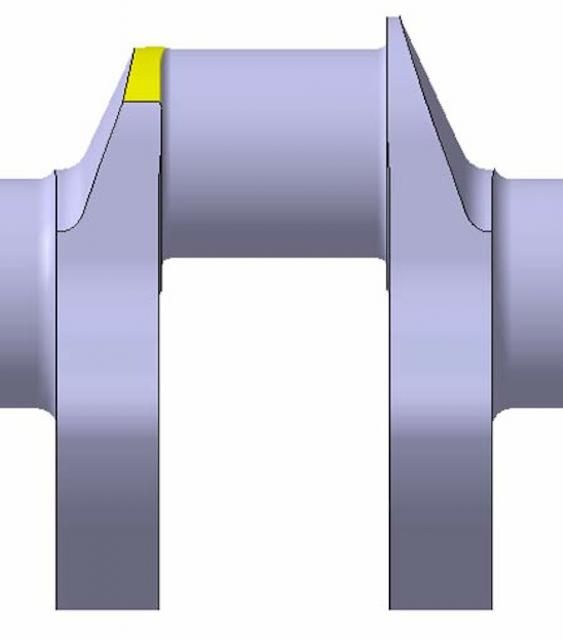
The other issue used to reduce weight when the crank is designed properly is the use of heavy metal. Heavy metal placed in the correct location is more effective in counter weighting as the weight is where it needs to be directly opposite, not rotated half way around the counterweight. The Nascar crank seen has a 83.5 mm stroke and a length a bit more than 600 mm and a weight of 16.5 kgs. The 928 crank is a bit under 700 mm. If we add 20% to its weight to make up for the length we are still under 20 kgs.
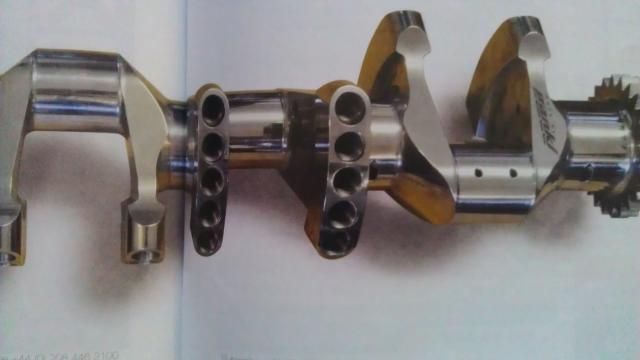
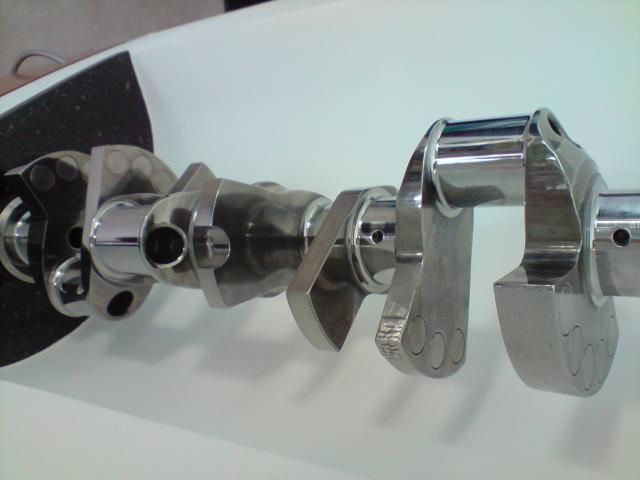
I plan to utilise the heavy metal I took from the Toyota crank and add this to my 928 crank.As mentioned before I may reduce the diameter of the main journals depending on if there is interest in a group buy of these cranks. If I go alone I will look at the reduced mains as means of reduced friction and weight etc etc.
Last edited by slate blue; 01-11-2014 at 06:45 AM.
#7
Addict
Rennlist Member
Rennlist Member
Thread Starter
I spoke to the transmission specialist today, on Monday Chevrolet will release the new Z06 Corvette and it is believed that the lower ratios will be more favourable to the usage in the 928. Currently there is two options, standard which has the better lower ratios 1 to 3 and the Z51 which has the better higher ratios 5 to 7. If the Z06 which will have around 620 ft pounds of torque has the taller lower ratios and the more performance orientated upper ratios, the comparison will look like this when the Porsche box has a 2.727 rear ratio and the Tremec a 4.11 ratio. Combined ratios quoted.
Porsche 928 ...............Tremec 6070
1, 10.27.......................10.93
2, 6.85..........................7.32
3, 4.88..........................5.34
4, 3.69..........................4.11
5, 2.727.........................2.91
6, ................................2.34
7, ................................1.97
The lower first gear will be a benefit with that carbon clutch so it doesn't need to be slipped as much. The high RPM potential of the engine (around 8,500+) will allow flexibility with the gear changes. So I may get to place this order this month as they are ordering a new box as soon as it is launched, here's hoping for good ratios.
Porsche 928 ...............Tremec 6070
1, 10.27.......................10.93
2, 6.85..........................7.32
3, 4.88..........................5.34
4, 3.69..........................4.11
5, 2.727.........................2.91
6, ................................2.34
7, ................................1.97
The lower first gear will be a benefit with that carbon clutch so it doesn't need to be slipped as much. The high RPM potential of the engine (around 8,500+) will allow flexibility with the gear changes. So I may get to place this order this month as they are ordering a new box as soon as it is launched, here's hoping for good ratios.
Trending Topics
#9
Greg in Anaheim is making some much lighter cranks but I don't thin in those strokes.
The psd has always been a thing of mine. I think it would work great tied into an ecu.
The psd has always been a thing of mine. I think it would work great tied into an ecu.
#10
Addict
Rennlist Member
Rennlist Member
Thread Starter
Parts for interested parties, I'm sure a few have wondered about the high RPM level that is being sought, I have looked at many aspects of the engine and basically to achieve this increase in RPM you need lighter and stronger parts. E.g the Pankl saw tooth rods only weigh 535 grams and have a very light small end although the pin still needs to be 100 grams.
The top of the engine is every bit as important, I will need aggressive camshafts with high lift, I am hopeful of 13.5 mm on the intake and around 12.7 to 13 mm on the exhaust. It will depend on the final flow figures. However I didn't want a heavy valvetrain which would be high in friction and wear rates. The aggressive cams often have the potential to wear more and by aggressive I mean fast ramp rates. Of course the quicker you can get the valves open and closed the better. It allows better cylinder filling and doesn't allow the pressure to bleed off as much.
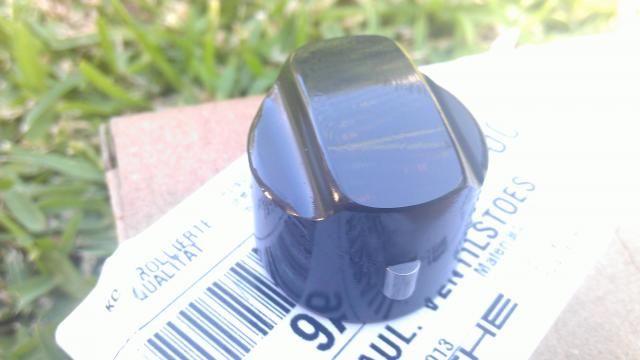
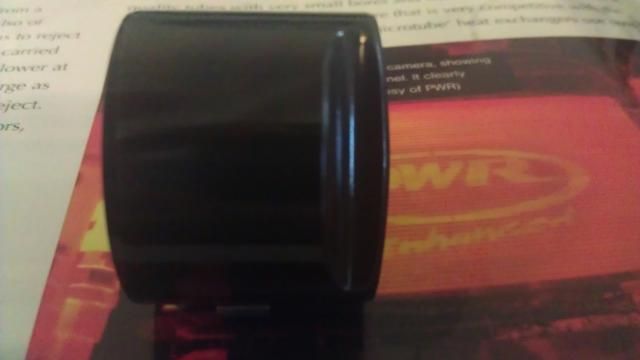
My little friend above will be very helpful in achieving this. The radius allows for quicker ramp rates much like a roller cam in a pushrod engine. You can see below it is hollowed out effectively and with oil weighs 30 grams. Good for about 9,000 rpm. Beehive springs must be used when these are fitted to the 928 head as the valve retainer needs to fit inside the tappet to have enough spring height.
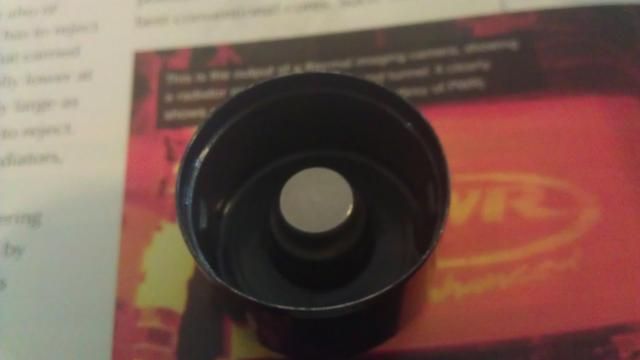
The machinist has quoted on the job and it will be done in a CNC but drawn first in CAD as we are also altering the inclined angle of the exhaust valves so that we can run 36 mm valves. This is all done at the same time. Custom guides will be made or potentially we we just make alloy plugs and in which case we may just run GT3 guides and utilise the 6 mm stem for further weight savings. BTW I thought he was pretty cluey when we were discussing how to do the bushings for the lifters, straight away he said "I'll machine the lifter bores oval and make an oval bushing" This will then be pushed in and the bores final machined with the keyway. That way they can never rotate. The tappet pictured has the same plunger height as the 928 tappets which is pretty convenient
The top of the engine is every bit as important, I will need aggressive camshafts with high lift, I am hopeful of 13.5 mm on the intake and around 12.7 to 13 mm on the exhaust. It will depend on the final flow figures. However I didn't want a heavy valvetrain which would be high in friction and wear rates. The aggressive cams often have the potential to wear more and by aggressive I mean fast ramp rates. Of course the quicker you can get the valves open and closed the better. It allows better cylinder filling and doesn't allow the pressure to bleed off as much.


My little friend above will be very helpful in achieving this. The radius allows for quicker ramp rates much like a roller cam in a pushrod engine. You can see below it is hollowed out effectively and with oil weighs 30 grams. Good for about 9,000 rpm. Beehive springs must be used when these are fitted to the 928 head as the valve retainer needs to fit inside the tappet to have enough spring height.

The machinist has quoted on the job and it will be done in a CNC but drawn first in CAD as we are also altering the inclined angle of the exhaust valves so that we can run 36 mm valves. This is all done at the same time. Custom guides will be made or potentially we we just make alloy plugs and in which case we may just run GT3 guides and utilise the 6 mm stem for further weight savings. BTW I thought he was pretty cluey when we were discussing how to do the bushings for the lifters, straight away he said "I'll machine the lifter bores oval and make an oval bushing" This will then be pushed in and the bores final machined with the keyway. That way they can never rotate. The tappet pictured has the same plunger height as the 928 tappets which is pretty convenient
#11
Addict
Rennlist Member
Rennlist Member
Thread Starter
My 55 mm oval throttle bodies are now in production, I will make a custom adaption flange that goes between the head and throttles. This will of course have the fuel rails. I am not sure as I haven't given it a lot of thought at this stage but the adaption flange may also have equalisation plumbing although this is built into the throttle as per the bleed screws seen in the ISO drawing.
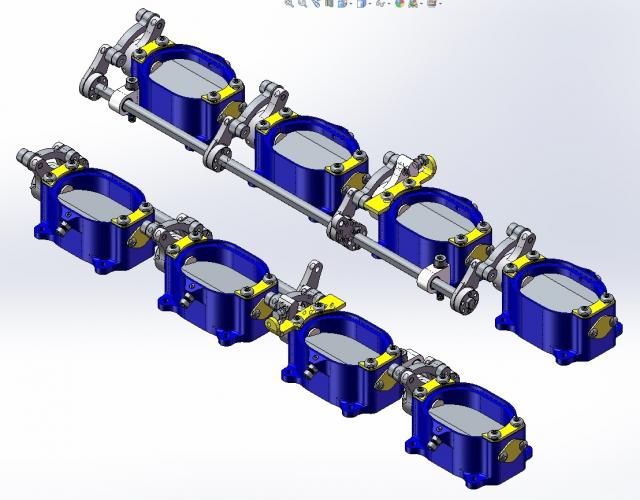
The other thing I have been seriously considering is plumbing in the EGR valve for street cruise. This normally slightly improves the economy and emissions but makes the car smoother by lessening the engine braking. This of course can be turned on and off from the cabin. This is important in a car with a high compression engine.
Below is an actual throttle from my 2V engine build, these throttles are 45 mm and that engine will drive an auto box so I need good torque so I needed to keep the airspeed up and this along with the close position of the throttle blade to the port should do a lot of taming of the cams. I hope You can see the tapered blade without the shaft and these are said to be 99.5% efficient and ths sized throttle was flowed on a high flowing Honda head with the full intake and they still flow 340 cfm. Not bad for such small throttles.
You can see the tapered blade without the shaft and these are said to be 99.5% efficient and ths sized throttle was flowed on a high flowing Honda head with the full intake and they still flow 340 cfm. Not bad for such small throttles.

There is some supporting evidence in the below picture, the tapered blade doesn't disturb the air as much as the throttles with shafts, this technology was still current spec in F1 last year as used on the Renault engine and discussed here.
http://www.f1technical.net/features/18247
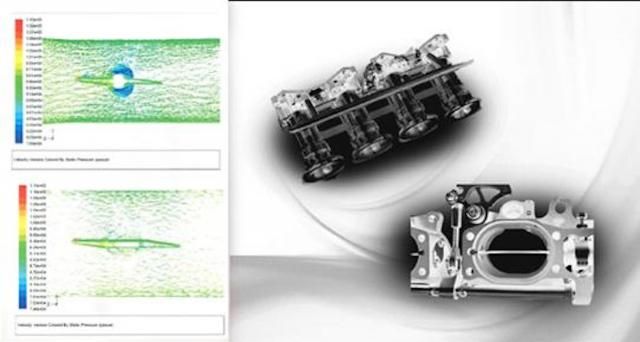
The throttles will then get a full carbon intake including the trumpets as this is the easiest way to do the job given the intake tract will be curved to be able to get the full necessary length. I am going to run the factory S4 fuel rails or at least that design with (I do have the option to make some stainless fuel rail) dampers but I will closely inspect them to see if they need any further improvement particularly in the bends. I have also had made a stainless upper fuel rails for top mount injectors. I will probably use my motorcycle injectors for that duty. These new injectors have 8 very fine spray holes per injector and should mist the fuel very well which will be important for high RPM duty.

The other thing I have been seriously considering is plumbing in the EGR valve for street cruise. This normally slightly improves the economy and emissions but makes the car smoother by lessening the engine braking. This of course can be turned on and off from the cabin. This is important in a car with a high compression engine.
Below is an actual throttle from my 2V engine build, these throttles are 45 mm and that engine will drive an auto box so I need good torque so I needed to keep the airspeed up and this along with the close position of the throttle blade to the port should do a lot of taming of the cams. I hope
 You can see the tapered blade without the shaft and these are said to be 99.5% efficient and ths sized throttle was flowed on a high flowing Honda head with the full intake and they still flow 340 cfm. Not bad for such small throttles.
You can see the tapered blade without the shaft and these are said to be 99.5% efficient and ths sized throttle was flowed on a high flowing Honda head with the full intake and they still flow 340 cfm. Not bad for such small throttles. 
There is some supporting evidence in the below picture, the tapered blade doesn't disturb the air as much as the throttles with shafts, this technology was still current spec in F1 last year as used on the Renault engine and discussed here.
http://www.f1technical.net/features/18247

The throttles will then get a full carbon intake including the trumpets as this is the easiest way to do the job given the intake tract will be curved to be able to get the full necessary length. I am going to run the factory S4 fuel rails or at least that design with (I do have the option to make some stainless fuel rail) dampers but I will closely inspect them to see if they need any further improvement particularly in the bends. I have also had made a stainless upper fuel rails for top mount injectors. I will probably use my motorcycle injectors for that duty. These new injectors have 8 very fine spray holes per injector and should mist the fuel very well which will be important for high RPM duty.
Last edited by slate blue; 01-18-2014 at 03:33 PM. Reason: Grammar
#12
Race Car
Thank you for putting this synopsis thread together.
*you're nuts!*
But in a good way.
I am curious though, about some of the design parameters seeming to go in opposite directions- you mentioned torque to drive the auto tranny, and the intent to have decent street driveability, but you are augering toward very radical cams, heaping airflow and high rpm efficiency/redline?
I wish I could fast forward to the resulting HP/TQ curves and then go through the design, but will enjoy following along! Rated.
*you're nuts!*
But in a good way.
I am curious though, about some of the design parameters seeming to go in opposite directions- you mentioned torque to drive the auto tranny, and the intent to have decent street driveability, but you are augering toward very radical cams, heaping airflow and high rpm efficiency/redline?
I wish I could fast forward to the resulting HP/TQ curves and then go through the design, but will enjoy following along! Rated.
#14
Addict
Rennlist Member
Rennlist Member
Thread Starter
Thank you for putting this synopsis thread together.
*you're nuts!*
But in a good way.
I am curious though, about some of the design parameters seeming to go in opposite directions- you mentioned torque to drive the auto tranny, and the intent to have decent street driveability, but you are augering toward very radical cams, heaping airflow and high rpm efficiency/redline?
I wish I could fast forward to the resulting HP/TQ curves and then go through the design, but will enjoy following along! Rated.
*you're nuts!*
But in a good way.
I am curious though, about some of the design parameters seeming to go in opposite directions- you mentioned torque to drive the auto tranny, and the intent to have decent street driveability, but you are augering toward very radical cams, heaping airflow and high rpm efficiency/redline?
I wish I could fast forward to the resulting HP/TQ curves and then go through the design, but will enjoy following along! Rated.
With regard to the cams in the 2V engine, I have had these solid camshafts for years and I did try to sell them as they are not the best for the auto application. The grind is 251/240 duration at 0,050" and the lift is 13.75 mm and 12.5 mm respectively, that is nett lift btw. The engine is now going to use steel valves because there will not be any point in revving past 7,000 rpm. Those valve sizes haven't been set but are likely to to around 54 / 41 mm respectively but in terms of valve to bore area they are small. I was going to go more lift and shorter duration but this will save me a couple of grand and use these parts up.



